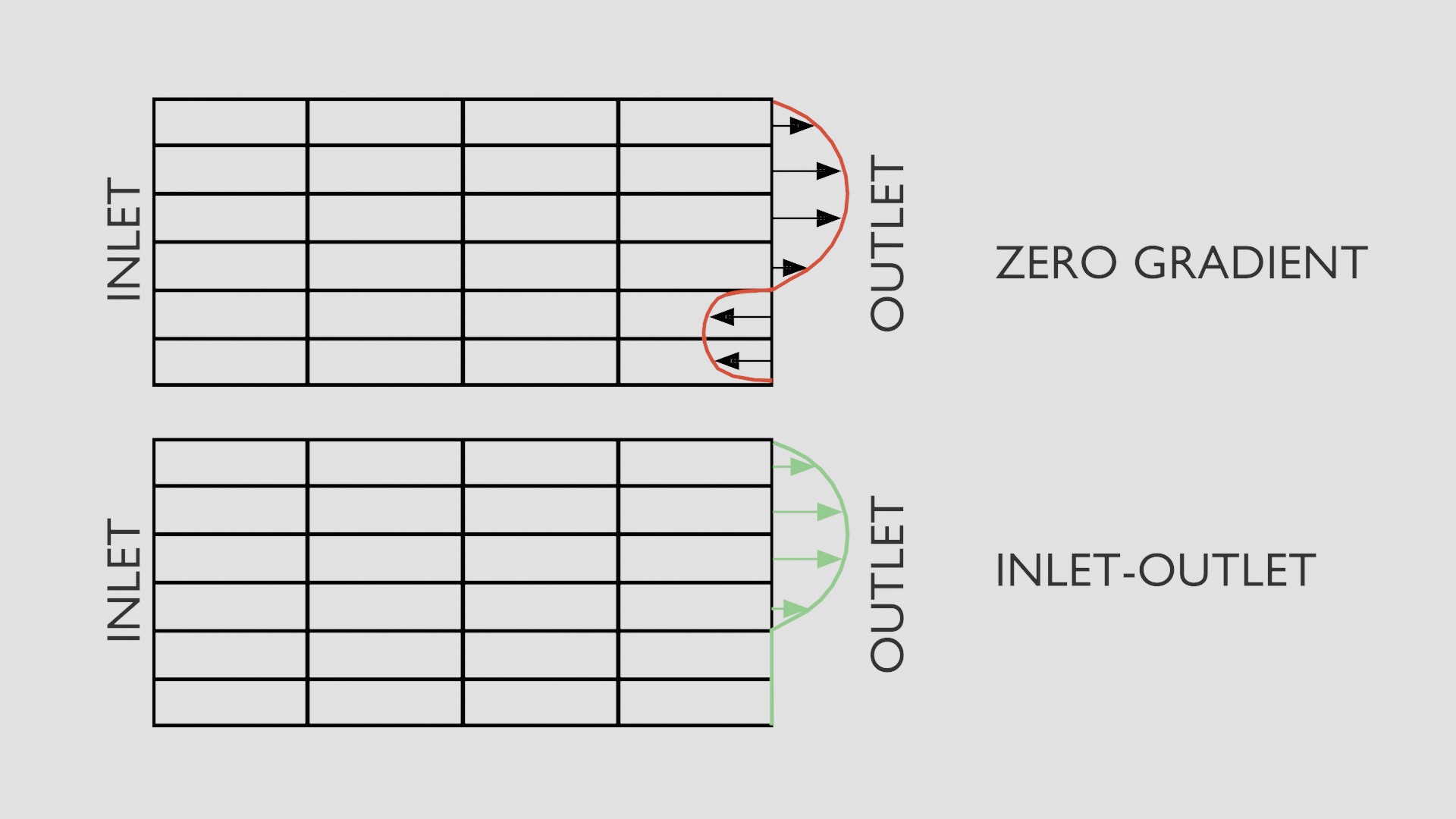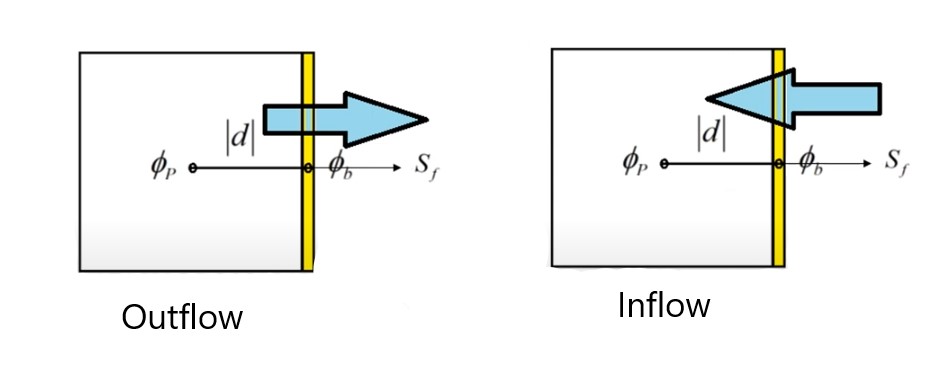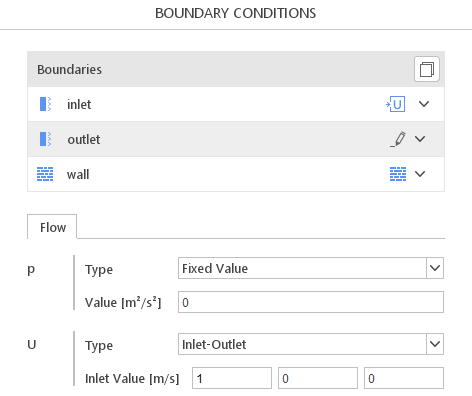Inlet-Outlet - Boundary Condition Description
Inlet-Outlet is an example of a mixed boundary condition that switches between Zero Gradient when the fluid flows out of the domain, and Fixed Value, when the fluid is flowing into the domain.
This boundary condition permits fluid to either enter or exit the domain, depending on local flow conditions. It is particularly useful in situations where the flow direction at the boundary may change, such as with recirculating flows or in cases of bidirectional flow.
The Inlet-Outlet condition is commonly applied to scalar fields (except \(p\)) at boundaries considered to be outlets. It can also be used with a vector field, such as velocity to prevent reverse flow. This helps to prevent numerical instability caused by unexpected inflow.
This boundary condition can also be used for scalar fields (temperature, concentration) in conjugation with a pressure inlet when the flow direction is not known in advance.
Inlet-Outlet - Boundary Condition Understanding Inlet-Outlet
Inlet-Outlet - Graphical Representation
Red velocity profile illustrates outlet conditions where a part of the flow exits the domain while another part experiences inflow. When the Inlet-Outlet is applied (green curve), the velocity profile changes. The segment of the profile where inflow occurs is switched to Fixed Value = 0 to ensure stability and no reverse flow.
The Inlet-Outlet calculates the flux at each boundary face and determines whether it should function as an inlet or an outlet based on the local flow direction. It then adjusts the flow properties accordingly by switching between Zero Gradient and Fixed Value.

Inlet-Outlet Governing Equations
The Inlet-Outlet belongs to the class of mixed boundary conditions - a combination of two boundary conditions: Fixed Value and Fixed Gradient. The general form of the mixed boundary condition can be described as:
- \(\phi_f\) is the face value enforced by the boundary condition
- \(w\) is the weight factor that determines the blend between Fixed Value and Fixed Gradient
- \(\phi_{ref}\) is a user-specified reference value
- \(\phi_P\) is the cell value at the cell center
- \(g_{ref}\) is the user-specified gradient at the boundary
- \(d\) is the distance between the cell centroid and the boundary cell face (see: Figure 2)
The Inlet-Outlet can be expressed as a special case of the mixed boundary condition. In this case, the weight factor operates between two values:
- 0 when the flow is out of the domain
- 1 when the flow is into the domain.
Also, the reference gradient value is constrained to always be zero: \(g_{ref} = 0\)
In the case of Inlet-Outlet, the mixed boundary condition simplifies to:
For the outflow, \(w=0\), the face value will reduce to: \(\phi_f = \phi_P\)
and Inlet-Outlet works as exactly as Zero Gradient.
For the inlet, \(w=1\), the face value is expressed as: \(\phi_f = \phi_b\)
The face value \(\phi_f\) will be equal to the specified value as in Fixed Value.
In other words, we can say the Inlet-Outlet boundary condition "advects" cell center value to the boundary when the fluid exits the domain, or it "advects" a specified reference value from the outside world when the flow is reversed.

When setting the outlet boundary condition for the velocity field, it is common practice to use the Inlet-Outlet condition with a fixed value of zero velocity. This approach helps to prevent reverse flows.
Inlet-Outlet - Boundary Condition Application & Physical Interpretation
The Inlet-Outlet is designed to efficiently handle flow at boundaries where the direction of flow can potentially reverse, making it particularly suitable for domains where inflow and outflow conditions are not strictly predefined. This boundary condition is adaptive, meaning it changes its behavior based on the local flow conditions at the boundary. Below are a few examples demonstrating how this boundary condition can be used and how to correctly interpret its meaning.
Inlet-Outlet in Aerodynamics applications
Example applications: car, aircraft aerodynamics, wind tunnel experiment
This problem can be solved by using simpleFoam (solver). The velocity boundary condition at the outlet can be defined as Inlet-Outlet. This is critical because, in the wake of the motorbike (or any other object), flow regions might experience reverse flow due to vortices or turbulent eddies.
| Physics | Velocity | Pressure |
|---|---|---|
Outflow | Inlet-Outlet | Fixed Flux Pressure |
| Tutorial | Description |
|---|---|
Simulation of free surface flow with a Volume of Fluid approach, analyzing the multiphase immiscible flow of water and air through a dam. |
Inlet-Outlet in VoF (Volume of Fluid) applications
Example applications: free surface flows, ship hull calculations, sloshing, ship hydrodynamics, wave impact on structures
For flows with distinctive interphase between two fluids, like water and air (Volume of Fluid method used in interFoam (solver)) Inlet-Outlet for a volume fraction \(\alpha\) can be applied for so-called atmospheric boundaries of the domain, above the free surface. It will allow in this situation, air entrainment into the domain.
| Physics | Velocity | Pressure | Phases \(\alpha\) |
|---|---|---|---|
Pressure Outlet | Pressure Inlet-Outlet Velocity | Fixed Value | Inlet-Outlet |
Inlet-Outlet in Heat Transfer applications
Example applications: room ventilation, room heating, electronic cooling, atmospheric flows
Buoyancy-driven flows with heat exchange can be simulated in the buoyantPimpleFoam (solver). The Inlet-Outlet for temperature T can be applied to the outlet out of the domain - to specify the fluid temperature in case of the backflows/reverse. It can also be used for temperature at the inlet when pressure condition is used, and we expect that the flow direction can change.
| Physics | Pressure | Velocity | Thermal - T |
|---|---|---|---|
Pressure Outlet | Fixed Value | Pressure Inlet-Outlet Velocity | Inlet-Outlet |
Inlet-Outlet in Species Transport applications
Example applications: industrial furnaces, jet engines, chemical process industry (chemically reacting foams)
The reactingParcelFoam (solver) can be applied for chemically reacting flows that involve heat transfer and multiphase particles modeling. In this application, the Inlet-Outlet defines, for example, the gas composition at the outlet in case of reverse flow.
| Physics | Pressure | Velocity | Species |
|---|---|---|---|
Pressure Outlet | Fixed Value | Pressure Inlet-Outlet Velocity | Inlet-Outlet |
| Tutorial | Description |
|---|---|
Simulation of carbon dioxide and ash particles released from a chimney into the atmosphere and investigating their dispersion in flowing air using species transport and Lagrangian particle simulation. |
Inlet-Outlet - Boundary Condition How to apply Inlet-Outlet in SimFlow
The definition of boundary conditions in SimFlow is both simple and intuitive. To specify the Inlet-Outlet boundary condition, the user must navigate to the Boundary Conditions panel, select the appropriate boundary, and choose the correct option from the drop-down menu.
Inlet Value needs to be specified by the user. This value is used when the boundary works as an inlet - when reverse flow appears.

Inlet-Outlet - Boundary Condition Inlet-Outlet - Alternatives
In this section, we propose boundary conditions that are alternative to Inlet-Outlet. While they may fulfill similar purposes, they might be better suited for a specific application and provide a better approximation of physical world conditions.
| Boundary Condition | Description |
|---|---|
belongs to the Neumann boundary conditions, sets the normal gradient of any variable to zero | |
Pressure Inlet-Outlet Velocity | allows velocity to adjust at the outlet to satisfy mass balance in the fluid domain. |
Outlet-Inlet | works contrary to Inlet-Outlet, applies a fixed value when the flow is directed out of the domain and a zero-gradient condition when the flow is directed into the domain |